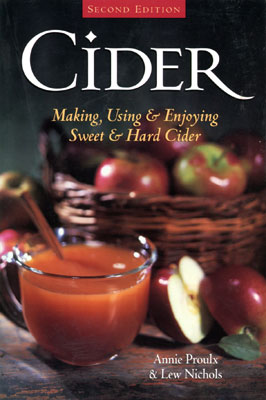 |
By Roberta Bailey
Cider is an extraordinarily versatile beverage that can be enjoyed in its many forms, sweet, semi-sweet, dry, sparkling, still, apple brandy and apple jack, as well as in a staggering number of hot and mulled drinks. Recently, the United States has rediscovered this beverage that quenched the thirst of its founders. Interest in cider making and hard cider has been growing as fast as the microbrewing industry. Hard cider is the fastest growing section of the liquor industry, riding on the enthusiasim of the microbrewing surge. With stricter sanitation regulations on fresh cider threatening the fresh cider market and the availability of any cider to the consumer, more individuals are taking an interest in pressing their own apples.
Cider – Making, Using, and Enjoying Sweet and Hard Cider by Annie Proulx and Lew Nichols (Storey Publishing, 1997) is an excellent how-to book on cider making, from choosing and planting the trees to what shape glasses to use when tasting your hard cider. In clear, simple language, it tells how to make different cider varieties, including blended and sparkling ciders; which cultivars to use for which flavors; how to cultivate an orchard; cider laws; how to make your own equipment; how to make vinegar and brandy; and how to cook with cider. The conditions needed to create certain cider qualities and the processes themselves are emphasized. Along with step-by-step instructions, the reader comes away with a strong sense of the role of this beverage has played in the world’s history, from the fierce competitions of the French to the regional apple cultivars grown in England, the Canadian provinces, and New England. The following recipes from Proulx and Nichol’s book show how versatile cider is in the kitchen.
Mulled Cider
2 cinnamon sticks
2 qt. dry, aromatic cider
1/2 t. allspice
dash of orange bitters
6 whole cloves
1/2 c. jasmine, clover, or orange blossom honey
1/2 c. dry rum
Break off a piece of cinnamon stick the length of your thumb, and put it and all the other ingredients in a heavy enamel pot. Heat the mixture over a low fire but do not let it boil. When it is steaming hot, rinse your best punch bowl with warm water, then strain the mulled cider into the bowl. Break the other cinnamon stick into slivered swizzle sticks, and put one in each clear glass mug. Ladle in the hot mull and serve immediately.
Smoked Sausages with Apples and Cider
(from Angele Landry-Day)
We like this spicy treat with a well-seasoned viaigrette dressing salad as Mme. Landry-Day recommends, with a dash of strong mustard in the dressing.
6 lg. cooking apples
2 T. butter
12 to 18 link sausages
1-1/2 c. cider
Peel the apples, core them, and cut them sections. Heat a pan and add the butter. Cook the apples, turning them gently so as not to break them. Prick the sausages and lay them on the apple slices. Add the cider, cover, and cook for 20 minutes.
Baked Beans in Cider
4 c. dried beans
cold water to cover
1 bottle semi-sweet cider
1/2 lb. salt pork
1 lg. onion, peeled
dry mustard
1/2 c. molasses
1 tbsp. salt
Pick over, wash and soak beans in water to cover for 12 hours. Add the cider to the drained beans, bring to a boil and boil for about one-half hour. Garnish the bottom of an earthen bean pot with the salt pork, reserving some strips for the top. Turn the beans and cider into the bean pot. Roll the whole onion in dry mustard and bury it in the middle of the beans. Pour the molasses over all. Place the rest of the salt pork on top of the beans, and add enough hot water to cover. Salt and cover the bean pot. Bake for 4 to 6 hours in a slow oven. An hour before the beans are done, uncover the pot and add water if the beans seem too dry.
You can order Storey/Garden Way books by calling 1-800-441-5700 or visiting www.Storey.com
